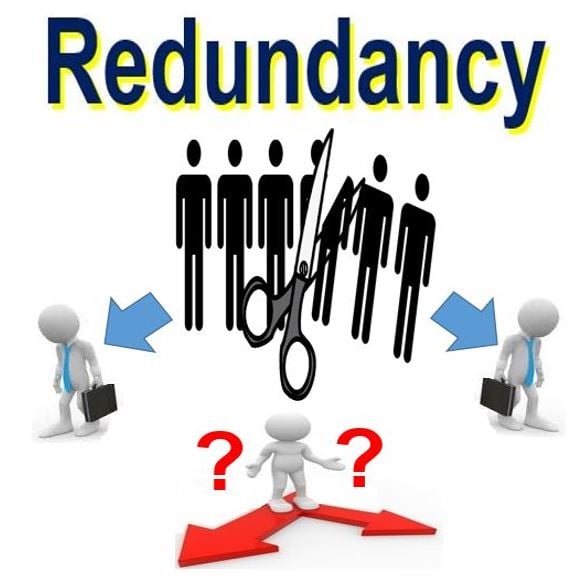Your Rights to Redundancy If Company Goes Bust: UK Employee Protections
Wiki Article
Checking Out the Operational Characteristics of Firm Redundancy and Its Long-Term Sustainability

Redundancy Methods for Organization Continuity
In order to guarantee nonstop operations, businesses need to implement efficient redundancy techniques for business connection. Redundancy in this context describes the replication of essential components or features within a system to mitigate the effect of prospective failures. By including redundancy strategies, companies can boost their resilience against disruptions brought on by various factors such as natural catastrophes, devices failings, or cyber-attacks.
One common redundancy technique is the implementation of back-up systems and data storage services. This entails producing matches of crucial data and systems that can be turned on in instance of a primary system failure. Additionally, companies can develop repetitive communication networks and source of power to preserve connectivity and operations throughout unanticipated events.
In addition, cross-training staff members to execute numerous roles within the business can serve as a valuable redundancy method. This ensures that important tasks can still be performed also if essential workers are not available as a result of disease or various other reasons. Generally, efficient redundancy methods are vital for organizations to maintain functional continuity and lessen the effect of possible disruptions.
Effect of Redundancy on Organizational Strength
Offered the crucial role redundancy methods play in guaranteeing business continuity, discovering the impact of redundancy on organizational resilience ends up being essential for comprehending the holistic functional characteristics of a firm. Redundancy, when purposefully implemented, can significantly contribute to enhancing a company's strength in the face of unexpected difficulties.In addition, redundancy can cultivate development and imagination within an organization as staff members feel encouraged to take calculated risks, understanding that there is a safety web to sustain them in case of failing. Generally, the effect of redundancy on business durability is extensive, shaping the long-term sustainability and success of a firm.
Stabilizing Effectiveness and Adaptability in Redundancy
Attaining an unified stability between functional efficiency and flexible adaptability is a pivotal obstacle in the tactical implementation of redundancy within companies. Efficient operations are important for preserving productivity and cost-effectiveness, making sure that sources are utilized ideally. Nonetheless, extreme focus on effectiveness alone can bring about rigidity, making it hard for organizations to adapt to unforeseen modifications or obstacles. On the other hand, flexibility allows companies to react nimbly to developing conditions, cultivating advancement and durability. Yet, way too much versatility without a strong functional structure can cause inefficiencies and variance.To balance performance and adaptability in redundancy planning, companies need to thoroughly analyze their functional requirements, market characteristics, and strategic objectives. Carrying out lean methods can improve performance by streamlining processes and removing waste, while promoting a culture of flexibility and continual enhancement can improve flexibility. Additionally, buying cross-training programs and robust interaction networks can help grow a functional workforce qualified of handling diverse jobs during periods of shift. Ultimately, see this here locating the best equilibrium in between effectiveness and versatility is important for constructing a resistant and sustainable organization despite uncertainty.
Long-Term Sustainability Through Redundancy Planning
To make certain long-lasting feasibility and security, companies need to strategically align their redundancy planning with long-term sustainability objectives, thus integrating operational effectiveness with flexible adaptability. Lasting sustainability through redundancy planning entails greater than simply short-term cost-cutting actions. It calls for an extensive critical strategy that prepares for future difficulties and opportunities. Firms need to view redundancy not as a reactive solution to immediate troubles but as an aggressive strategy for long-term success. By incorporating redundancy planning with sustainability goals, companies can develop a resistant structure that can hold up against different market variations and inner adjustments.
Proactive Procedures for Lasting Company Procedures
Exactly how can business proactively improve their functional sustainability for long-lasting success? Implementing proactive measures is important for business intending to ensure lasting operations.In addition, promoting a society of continual improvement and learning within the company can boost flexibility to altering market conditions and consumer needs. Encouraging employee participation in decision-making procedures and providing chances for professional advancement can improve morale, performance, and overall performance. Establishing clear objectives, keeping an eye on crucial performance signs, and on a regular basis reviewing development are important elements of aggressive sustainability monitoring.
Working together with vendors, consumers, and various other stakeholders to promote sustainable techniques throughout the supply chain can develop a surge impact of favorable effect - redundancy pay if company goes bust. By taking aggressive steps towards operational sustainability, business can construct strength, drive innovation, and safeguard their long-lasting success in an ever-evolving service landscape
Conclusion

In the world of organizational monitoring, the strategic deployment of company redundancy stands as an essential yet elaborate practice that demands a delicate equilibrium between functional performance and long-term practicality. By dissecting the functional dynamics that underpin company redundancy and reviewing its wider ramifications for business resilience and flexibility, a nuanced understanding of how redundancy methods can form the future trajectory of a company starts to unravel.Given the vital role redundancy approaches play in making certain business continuity, hop over to these guys checking out the effect of redundancy on organizational durability ends up being important for comprehending this content the all natural functional characteristics of a firm. Overall, the influence of redundancy on organizational resilience is profound, shaping the lasting sustainability and success of a business.
In conclusion, recognizing the operational dynamics of company redundancy is essential for making sure lasting sustainability.
Report this wiki page